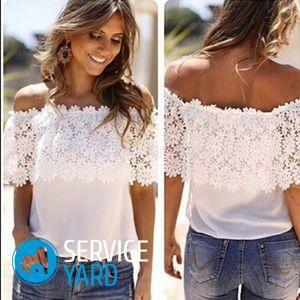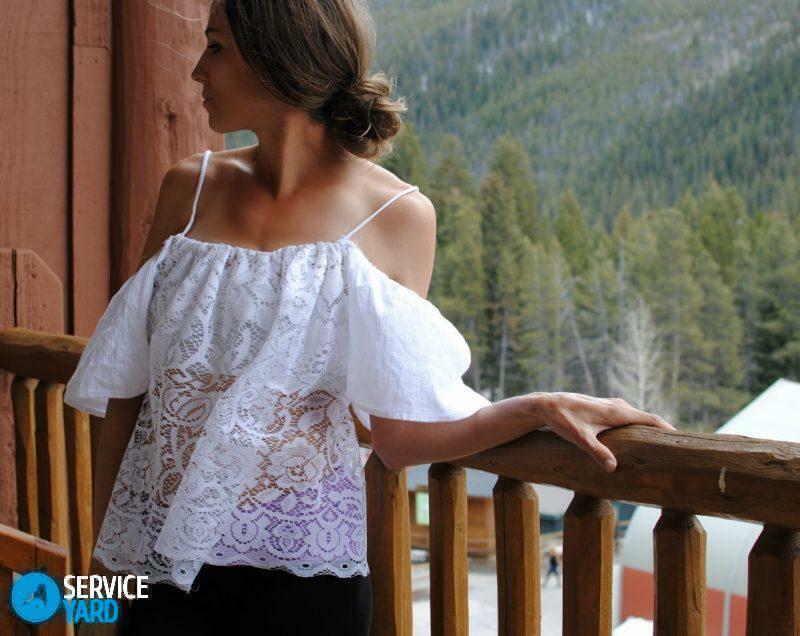
- The history of
- The advantages of products in our time
- The blouse pattern
- We turn to the blouse
- Making dresses "The young lady-peasant woman" with the skirt "The sun"
Along with the extraordinary, bright and literally screaming images, young ladies are increasingly looking forthose clothing options that would emphasize the tenderness and feminity of the girls of nature. As practice shows, just such outfits give an opportunity to attract to their person more male attention and inquisitive looks of girls. Recently, dresses and blouses have begun to gain popularity under the name "Maiden-Peasant Woman".This style remains relevant for several hundred years. It's no wonder, because such a garment emphasizes all the virtues of a girl's figure, making her silhouette very slim. Every year, designers improve it more and more, making the garment more attractive, more refined. In this article, we'll show you how to sew a dress yourself, how a peasant blouse can look like with your own hands, and give some advice on how to wear it.
to the contents ↑History of the
creation For the first time in history, such a dress appeared in the 18th century. Remember the paintings of that time: most of the young ladies are depicted in long and lush dresses. Imagine, however original the girl in a modest and simple dress looked on their background.
Just invented at that time the style of the dress was the most comfortable than the outfits with corsets and lush hem, therefore soon gained a large number of female fans, among whom were noble ladies. As soon as such attire became fashionable, women began to sew themselves dresses-peasant women from thin cotton fabric. Under the clothes they wore several layers of underwear.
The first styles possessed the following qualities:
- The garment focused on the waist of the girl.
- The shoulders of women have always been open.
- The sleeves were quite fluffy.
- The skirt was wide. Due to this factor, the waist stood out even brighter.
Important! Noblemen, accustomed to luxury, decorated their dresses with expensive materials: stones, embroideries and expensive threads, to once again emphasize their status.
to content ↑Advantages of products in our time
Now a self-made peasant blouse or dress is an excellent addition for the summer "bow":
- This type of clothing will never constrain the natural movements.
- Also it will not be too hot in the stuffy summer days.
- In addition to comfort, such images always add femininity and charm to the girl, the posture will become much more graceful, and the gait - more smoothly. The owner of the outfit can be compared with a swan.
- Modern designers offer us to play with the blouse or the top of the dress, offering a variety of sleeve options. They also distinguish three types of hem length: mini, midi and maxi.
As for how to sew a peasant blouse with their own hands, then the product of this style is simple, if compared with other kinds of similar clothes. In addition, the manufacture of such a piece of clothing will help beginners seam the hand.
to the table of contents ↑Blouse shape
Before you cut out our future product, you need to take the following measurements:
- Shoulder width.
- Chest circumference.
- The length of the manufactured product. It, as a rule, needs to be measured from the armpit.
- Waist circumference. This measurement is necessary for the manufacture of a belt part.
- Circumference of the wrist.
- Width and length of the future sleeve.
For making a pattern on which the peasant blouse will be manufactured by hand, it will be necessary to follow the same algorithm:
- Draw a piece of ¾ width from the chest line girth.
- From two sides of the segment, hold up two perpendicular lines - the length of the product with the addition of 15-20 cm.
- From the upper ends of the newly drawn segments, measure 11 cm inside. Draw this segment at an angle of 45 degrees, the approximate length will be 15 cm.
- From the ends lead up by 10 cm and close the drawing with a horizontal line.
The result is a backrest pattern.
After that it will be necessary to draw a pattern of the sleeve. To do this, also follow the suggested order of actions:
- To calculate the upper part of the sleeve, you should take the measurement "width between the shoulders" and add to it ¼ of this number. From the amount that has turned out, subtract the sum of the width of the transmission and the width of the backrest. The resulting number is divided by 2. The resulting number is the upper part of the sleeve. Draw this piece on paper.
- Draw a perpendicular from the end of the line to 10 cm.
- Next, as in the first case, you need to step back down 11 cm and hold a 15-centimeter cut at an angle of 45 degrees.
- From the points obtained, measure the desired length of the sleeve.
Proceed to tailoring the blouse
Below, two ways will be given how to sew a blouse-peasant woman with his own hands of different styles. Both versions are very simple - it is not difficult to make such a product for any young seamstress.
The simplest version of
This style is sewn very simply. It's enough for a girl to be neat and to master the basic technique of using a sewing machine.
Important! The finished product will look very expensive, but at the same time, gently and feminine.
 So, here's the course of action that you have to follow:
So, here's the course of action that you have to follow:
- Draw on the material two rectangular figures 110 by 80 cm, then cut them.
- Sew around the edges and patch the flaps with an overlock.
- On both sides of the bottom edge of the rectangles, set aside 25 cm and mark these points. Then draw the perpendicular lines up, their length is 45 cm. Cut the material along the lines. As a result, the basis of the future blouse should turn out.
- To sew and trim overlock the resulting seams of sleeves and sides.
- For further tailoring blouse-peasant woman with his own hands it is necessary to process the neck. To do this, twist the edge by 10 cm, then sew it with such images, so that later there are two kulisks for future erasers.
- If desired, sew on the edge of the neck of the braid and insert the rubber bands.
- Tighten the lower part of the product and sleeves, if desired, sew lace and braid. The blouse is made.
Important! In order to complete the image, you can independently make a blouse strap or belt.
Blouse with a single lateral seam
This style will be even slightly simpler than the previous one in terms of cut and tuck. In addition to the fabric, we will need the following materials for its production:
- Lace 10-15 cm wide
- Narrow lace ribbon.
Let's turn to the garment:
- In order to find the product on the canvas, you need to draw a rectangle with a width of 45 cm and a length of 130 cm, then cut it and fold it in half. The seam will be just one, as it is written in the title of the item.
- On the sides of the armhole you need to draw rectangles( width - 30 cm, length - 7 cm), then round the fabric over them and cut out.
- In order to cut the neck, you need to make a V-neck in front.
- Sew a side seam, then the ones that are on the shoulders. Finally, handle the overlock.
- Then you need to cut out your sleeves. To do this, draw two rectangles 60 by 65 cm and process the armhole line, then fold them in half and stitch them, then sew to the future blouse.
- At the edges of the sleeves to make the curtains, sewing a strip of lace and vdev gum.
- To complete the sewing of the blouse peasant woman with his own hands, it is necessary to process the neck. To do this, take a previously prepared wide lace ribbon, attach it to the throat opening and stitch it on the machine, forming folds.
Important! To enhance the quality and aesthetic component, you can treat the edge with a narrow lace ribbon.
to the table of contents ↑Dress manufacturer "Young lady-peasant woman" with a skirt "Sun"
- Calculate the consumption of tissue for hem-sun can be proposed by the method: Width of the waist dividing by 2p( n = 3.14).
- Then add the length of the hem and the allowances to the seams.
Important! The amount of tissue should always be determined correctly. If the skirt is not very long - the width of the canvas should be enough. Well, if you plan a length of midi or maxi, most likely, you will need to cut out two semicircles because the calculated amount of material will greatly exceed the width.
In order to make the dress-peasant woman, you must strictly follow this algorithm. The dress always starts sewing from the bodice:
- To do this, first process the sleeves, collecting them in the lower part of the elastic band, which will later be in the manufactured cuff-backstage.
- For such cuffs, you need to prepare a special finish, cutting for this 7-centimeter oblique strips, stitching them in one tape, press along the entire length and fold it in half, and the stitch seams will need to be ironed.
- Any cut of the tape will need to be swept away, and the other to stitch along the bottom edges of the sleeves.
- The front and back seams of the sleeves are sewn and swept, forming a pass for the future rubber band.
- Then, fold the kuliska in two parts along a pressed line and seam the joint with the sleeve along the seam.
- After that, the bodice is swept along the raglan and side cuts.
- The wedge at the top of the bodice is sewn in the same way as the kulisks on the sleeves.
- After full production of the kulisok, rubber bands are inserted.
Important! When the work with the bodice is finished, try it on. Such a procedure is necessary not only to surely adjust the tension of the inserted rubber bands, but also to show for itself the line along which the skirt will be sewn.
As for the skirt:
- It is chipped together with the bodice by the marks that you just made.
- Then the skirt is turned back to the front and "put" in the bodice on the front of the bodice.
- In general, the skirt and bodice are chipped only four times: according to the median notes and seams on the sides, after that two parts are sewn together and poured - you can take a rubber thread.
Important! After that, the almost made dress is again worn on itself, finally level its length and process the edges.
After the girl herself sewed a peasant dress, she should pay attention to small details and add at the end of work to her original product, sewing some decorative elements.
The dress is ready!
A sewn dress or a peasant blouse with their own hands will always add them to the masters of originality and femininity. In this article, we have taught self-tailoring of this type of clothing. We hope, now you have more confidence in your abilities, and you already have many ideas how to improve our basic models.
